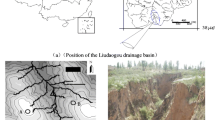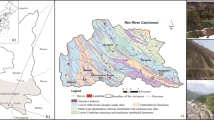Abstract
In order to study the evolution of the hydrological environment in loess excavation and filling project under multi-year precipitation infiltration, the hydrological responses of the excavation and filling area in Yan’an New District are simulated, based on the actual precipitation data of several years and field monitoring results. In addition, the drainage rate of the blind ditch is defined to characterize the drainage state of the blind ditch. Considering the variation of the drainage state and multi-year precipitation infiltration, different simulated cases are established. The results show that the proposed model is verified by the field monitoring results, which could reliably reflect the evolution of the pore water pressure (PWP) and the groundwater table (GWT). The transient saturated zone is formed near the excavation and filling interface due to the multi-year precipitation infiltration. And the formation and development of the transient saturated zone are closely related to the hydrological response of the loess excavation and filling area. The spatial and temporal variations of PWP and GWT are mainly affected by the changes in precipitation infiltration and drainage capacity of the blind ditch. Moreover, the hydrological response has a certain hysteresis to precipitation and is controlled by the topography and stratum difference of the undisturbed foundation. The research results should be helpful for the stability evaluation of loess excavation and filling project and the design of drainage facilities.









Similar content being viewed by others
Data availability
All data that support the findings of this study are available from the corresponding author upon reasonable request.
References
Allison LE (1947) Effect of microorganisms on permeability of soil under prolonged submergence. Soil Sci 63:439–450
Baveye P, Vandevivere P, Hoyle BL et al (1998) Environmental impact and mechanisms of the biological clogging of saturated soils and aquifer materials. Crit Rev Environ Sci Technol 28:123–191
Cai HE, Zhang JW, Zheng JG et al (2019) Hydrogeology features of loess hilly gully region in Yan’an. Geotech Eng Tech 33(5):288–292 (in Chinese)
Chen G, Meng XM, Qiao L et al (2018) Response of a loess landslide to rainfall: observations from a field artificial rainfall experiment in Bailong River Basin, China. Landslides 15(5):895–911
Chen LW, Zeng W, Xu DQ et al (2017) Numerical simulation of groundwater flow in loess hilly and gully area under the influence of excavating and filling engineering. J Hefei Univ Technol Nat Sci 40(10):1404–1411 (in Chinese)
Duan X, Dong Q, Men YM et al (2018) Change of groundwater and water content of loess high fill in gully regions. Chin J Geotech Eng 40(9):1753–1758 (in Chinese)
Gu TF, Zhang MS, Wang JD et al (2019) The effect of irrigation on slope stability in the Heifangtai Platform, Gansu Province, China. Eng Geol 248:346–356
Gvirtzman H, Shalev E, Dahan O et al (2008) Large-scale infiltration experiments into unsaturated stratified loess sediments: monitoring and modeling. J Hydrol 349(1):214–229
Hou XK, Vanapalli SK, Li TL (2018) Water infiltration characteristics in loess associated with irrigation activities and its influence on the slope stability in Heifangtai loess highland, China. Eng Geol 234:27–37
Hussain F, Wu RS, Shih DS (2022) Water table response to rainfall and groundwater simulation using physics-based numerical model: WASH123D. J Hydrol: Reg Stud 39:100988
Jie YX, Wei YJ, Wang DL et al (2021) Numerical study on settlement of high-fill airports in collapsible loess geomaterials: a case study of Lüliang Airport in Shanxi Province, China. J Cent South Univ 28(3):939–953
Li P, Li TL, Vanapalli SK (2016) Influence of environmental factors on the wetting front depth: a case study in the Loess Plateau. Eng Geol 214:1–10
Liang YH, Shui WH, Lu SF (2022) Field practice and ground settlement behaviors of a land creation case in loess area of China. Bull Eng Geol Environ 81(11):462
Liu JL, Xu Q, Li PL et al (2022) Saturated permeability of compacted loess based on low-field nuclear magnetic resonance (NMR). Bull Eng Geol Environ 81(11):464
Ma Y, Wang JD, Peng SJ et al (2016) Deformation and failure mechanism of high sticking loess slope. Chin J Geotech Eng 38(3):518–528 (in Chinese)
Meng XF, Liao HJ, Zhang JW (2020) Infiltration law of water in undisturbed loess and backfill. Water 12(9):2388
Ng CWW, Sadeghi H, Hossen SKB et al (2016) Water retention and volumetric characteristics of intact and re-compacted loess. Can Geotech J 53(8):1258–1269
Proto CJ, DeJong JT, Nelson DC (2016) Biomediated permeability reduction of saturated sands. J Geotech Geoenviron Eng 142(12):04016073
Qiu X, Li JH, Jiang HB et al (2022) Evolution of the transient saturated zone and stability analysis of slopes under rainfall conditions. KSCE J Civ Eng 26(4):1618–1631
Tan HB, Liu ZH, Rao WB et al (2017) Stable isotopes of soil water: implications for soil water and shallow groundwater recharge in hill and gully regions of the Loess Plateau, China. Agr Ecosyst Environ 243:1–9
Tu XB, Kwong AKL, Dai FC et al (2009) Field monitoring of rainfall infiltration in a loess slope and analysis of failure mechanism of rainfall-induced landslides. Eng Geol 105(1):134–150
van Genuchten MT (1980) A closed-form equation for predicting the hydraulic conductivity of unsaturated soils. Soil Sci Soc Am J 44(5):892–898
Wang CX, Li TL, Li P et al (2022) Verification on the mode of moisture transfer in the vadose zone of thick loess. Hydrol Processes 36(8):e14656
Wang JD, Li P, Ma Y et al (2018) Influence of irrigation method on the infiltration in loess: field study in the Loess Plateau. Desalin Water Treat 110:298–307
Xiao T, Li P, Pan ZH et al (2022) Relationship between water retention capacity and pore-size distribution of compacted loess. J Soils Sediments 22(12):3151–3165
Xu L, Yan DD (2019) The groundwater responses to loess flowslides in the Heifangtai platform. Bull Eng Geol Environ 78(7):4931–4944
Yan L, Chen MJ, Hu P et al (2021) An analysis on the influence of precipitation infiltration on groundwater under different irrigation conditions in the semi-arid area. Water Supply 21(3):1111–1118
Yao YG, Zhang YC, Ma C et al (2022) Study on deformation of filling composite geological body in loess mountainous area. Nat Hazard 110(3):1469–1493
Yin XX, Wang CL, Dong HJ et al (2016) Characteristics of groundwater flow field after land creation engineering in the hilly and gully area of the Loess Plateau. Arabian J Geosci 9(14):646
Yu YT, Zheng JG, Zhang JW et al (2021) Variation behavior of pore water pressure in loess deep filled ground. J Civ Environ Eng 43(6):10–16 (in Chinese)
Zeng L, Bian HB, Shi ZN et al (2017) Forming condition of transient saturated zone and its distribution in residual slope under rainfall conditions. J Cent South Univ 24(8):1866–1880
Zeng L, Xiao LY, Zhang JH et al (2020) Effect of the characteristics of surface cracks on the transient saturated zones in colluvial soil slopes during rainfall. Bull Eng Geol Environ 79(2):699–709
Zhai Q, Rahardjo H, Satyanaga A et al (2017) Effect of bimodal soil-water characteristic curve on the estimation of permeability function. Eng Geol 230:142–151
Zhang HX, Zeng RQ, Zhang Y et al (2022) Subsidence monitoring and influencing factor analysis of mountain excavation and valley infilling on the Chinese Loess Plateau: a case study of Yan’an New District. Eng Geol 297:106482
Zhang JW, Yu YT, Li P et al (2016) Groundwater monitoring and analysis of high fill foundation in loess hilly-gully region. J xi’an Univ Arch Tech (nat Sci Ed) 48(4):477–483 (in Chinese)
Zhao WH, Yang XJ, Wang BZ et al (2022) Study on the law of water migration and settlement at the interface of loess filled area under rainfall. Chin J Geotech Eng 44(9):1710–1720 (in Chinese)
Zhao ZQ, Dai FC, Min H et al (2021) Field infiltration of artificial irrigation into thick loess. Eng Geol 294:106388
Funding
This study would not have been possible without financial support from the National Natural Science Foundation of China (Grant No. 41402264) and the Natural Science Basic Research Plan in Shaanxi Province of China (Grant No. 2019JQ-085).
Author information
Authors and Affiliations
Corresponding author
Ethics declarations
Competing interests
The authors declare no competing interests.
Rights and permissions
Springer Nature or its licensor (e.g. a society or other partner) holds exclusive rights to this article under a publishing agreement with the author(s) or other rightsholder(s); author self-archiving of the accepted manuscript version of this article is solely governed by the terms of such publishing agreement and applicable law.
About this article
Cite this article
Wang, T., Liu, F., Yu, Y. et al. Numerical analysis of hydrological response in loess excavation and filling area under multi-year precipitation infiltration. Bull Eng Geol Environ 82, 372 (2023). https://doi.org/10.1007/s10064-023-03391-1
Received:
Accepted:
Published:
DOI: https://doi.org/10.1007/s10064-023-03391-1




